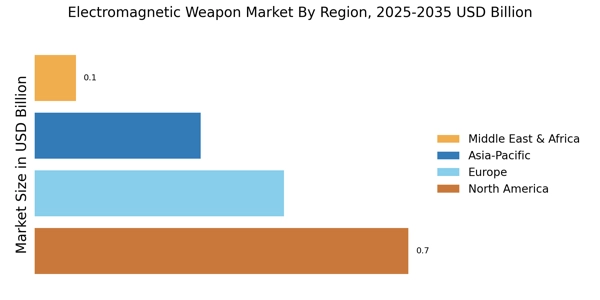Shift Towards Non-Lethal Options
The Electromagnetic Weapon Market is witnessing a notable shift towards non-lethal weaponry, driven by the need for crowd control and minimizing collateral damage. Governments and military organizations are increasingly recognizing the advantages of non-lethal electromagnetic weapons, such as those that incapacitate without causing permanent harm. This trend is particularly relevant in urban warfare scenarios, where the use of lethal force may not be appropriate. The market for non-lethal electromagnetic weapons is expected to expand, with projections indicating a potential increase in demand by approximately 15% over the next five years. This shift reflects a broader strategy to enhance operational flexibility while adhering to international humanitarian laws, thereby influencing the overall dynamics of the Electromagnetic Weapon Market.
Increased Investment in Defense Technologies
The Electromagnetic Weapon Market is benefiting from increased investment in defense technologies by various nations. As geopolitical tensions rise, countries are prioritizing the development of advanced military capabilities, including electromagnetic weapons. This trend is evidenced by substantial budget allocations for research and development in defense sectors, with some nations reporting increases of up to 30% in defense spending. Such investments are likely to accelerate the deployment of cutting-edge electromagnetic weapon systems, enhancing national security and deterrence capabilities. Furthermore, partnerships between governments and private defense contractors are fostering innovation, which may lead to breakthroughs in electromagnetic weapon technology. This influx of capital and collaboration is expected to drive market growth and expand the range of available systems in the Electromagnetic Weapon Market.
Growing Demand for Advanced Defense Solutions
The Electromagnetic Weapon Market is experiencing growing demand for advanced defense solutions, particularly in response to evolving threats. As military strategies adapt to new forms of warfare, including cyber and asymmetric threats, the need for effective countermeasures becomes paramount. Electromagnetic weapons, with their ability to disrupt electronic systems and incapacitate adversaries, are increasingly viewed as essential components of modern defense arsenals. Market analysts suggest that the demand for such solutions could lead to a market expansion of approximately 25% over the next decade. This trend underscores the importance of integrating electromagnetic weaponry into comprehensive defense strategies, as nations seek to enhance their operational capabilities and maintain a technological edge over potential adversaries.
International Collaboration and Arms Treaties
The Electromagnetic Weapon Market is influenced by international collaboration and arms treaties aimed at regulating the use of advanced weaponry. As nations engage in discussions regarding the ethical implications of electromagnetic weapons, there is a growing emphasis on establishing frameworks that govern their development and deployment. Such treaties may impact market dynamics by promoting transparency and accountability among nations. Additionally, collaborative research initiatives between countries can lead to shared technological advancements, potentially accelerating the evolution of electromagnetic weapon systems. This collaborative approach may foster a more stable international environment, while also shaping the future landscape of the Electromagnetic Weapon Market, as nations navigate the complexities of defense and diplomacy.
Technological Advancements in Electromagnetic Weaponry
The Electromagnetic Weapon Market is experiencing rapid technological advancements that enhance weapon capabilities. Innovations in directed energy systems, such as high-energy lasers and microwave weapons, are becoming more prevalent. These advancements not only improve the effectiveness of electromagnetic weapons but also reduce operational costs. For instance, the integration of advanced targeting systems and improved power sources is likely to increase the precision and reliability of these weapons. As nations invest in research and development, the market is projected to grow significantly, with estimates suggesting a compound annual growth rate of over 20% in the coming years. This trend indicates a shift towards more sophisticated and efficient electromagnetic weapon systems, which could redefine military strategies and defense postures.


















Leave a Comment